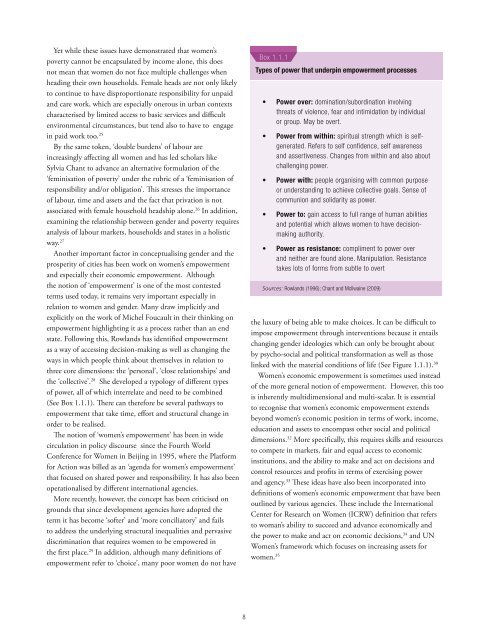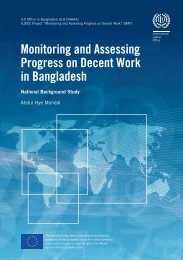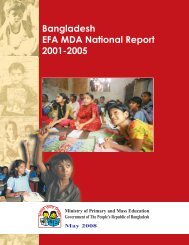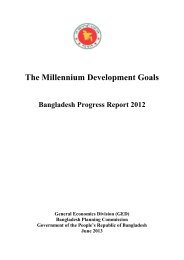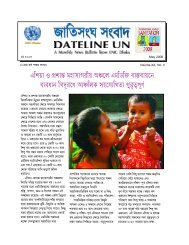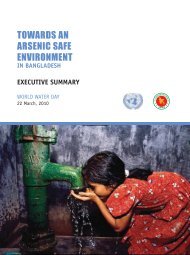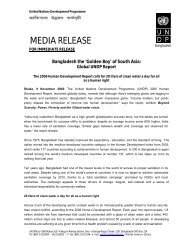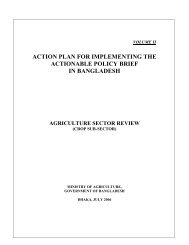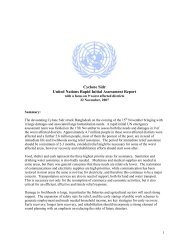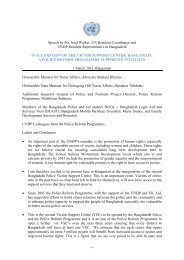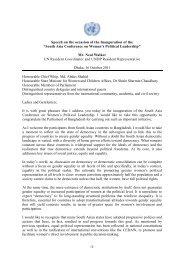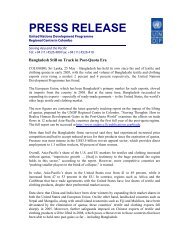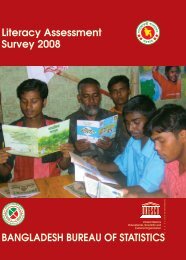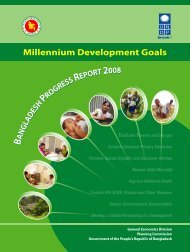STATE OF WOMEN IN CITIES 2012-2013 - UN-Habitat
STATE OF WOMEN IN CITIES 2012-2013 - UN-Habitat
STATE OF WOMEN IN CITIES 2012-2013 - UN-Habitat
You also want an ePaper? Increase the reach of your titles
YUMPU automatically turns print PDFs into web optimized ePapers that Google loves.
Yet while these issues have demonstrated that women’s<br />
poverty cannot be encapsulated by income alone, this does<br />
not mean that women do not face multiple challenges when<br />
heading their own households. Female heads are not only likely<br />
to continue to have disproportionate responsibility for unpaid<br />
and care work, which are especially onerous in urban contexts<br />
characterised by limited access to basic services and difficult<br />
environmental circumstances, but tend also to have to engage<br />
in paid work too. 25<br />
By the same token, ‘double burdens’ of labour are<br />
increasingly affecting all women and has led scholars like<br />
Sylvia Chant to advance an alternative formulation of the<br />
‘feminisation of poverty’ under the rubric of a ‘feminisation of<br />
responsibility and/or obligation’. This stresses the importance<br />
of labour, time and assets and the fact that privation is not<br />
associated with female household headship alone. 26 In addition,<br />
examining the relationship between gender and poverty requires<br />
analysis of labour markets, households and states in a holistic<br />
way. 27<br />
Another important factor in conceptualising gender and the<br />
prosperity of cities has been work on women’s empowerment<br />
and especially their economic empowerment. Although<br />
the notion of ‘empowerment’ is one of the most contested<br />
terms used today, it remains very important especially in<br />
relation to women and gender. Many draw implicitly and<br />
explicitly on the work of Michel Foucault in their thinking on<br />
empowerment highlighting it as a process rather than an end<br />
state. Following this, Rowlands has identified empowerment<br />
as a way of accessing decision-making as well as changing the<br />
ways in which people think about themselves in relation to<br />
three core dimensions: the ‘personal’, ‘close relationships’ and<br />
the ‘collective’. 28 She developed a typology of different types<br />
of power, all of which interrelate and need to be combined<br />
(See Box 1.1.1). There can therefore be several pathways to<br />
empowerment that take time, effort and structural change in<br />
order to be realised.<br />
The notion of ‘women’s empowerment’ has been in wide<br />
circulation in policy discourse since the Fourth World<br />
Conference for Women in Beijing in 1995, where the Platform<br />
for Action was billed as an ‘agenda for women’s empowerment’<br />
that focused on shared power and responsibility. It has also been<br />
operationalised by different international agencies.<br />
More recently, however, the concept has been criticised on<br />
grounds that since development agencies have adopted the<br />
term it has become ‘softer’ and ‘more conciliatory’ and fails<br />
to address the underlying structural inequalities and pervasive<br />
discrimination that requires women to be empowered in<br />
the first place. 29 In addition, although many definitions of<br />
empowerment refer to ‘choice’, many poor women do not have<br />
Box 1.1.1<br />
Types of power that underpin empowerment processes<br />
• Power over: domination/subordination involving<br />
threats of violence, fear and intimidation by individual<br />
or group. May be overt.<br />
• Power from within: spiritual strength which is selfgenerated.<br />
Refers to self confidence, self awareness<br />
and assertiveness. Changes from within and also about<br />
challenging power.<br />
• Power with: people organising with common purpose<br />
or understanding to achieve collective goals. Sense of<br />
communion and solidarity as power.<br />
• Power to: gain access to full range of human abilities<br />
and potential which allows women to have decisionmaking<br />
authority.<br />
• Power as resistance: compliment to power over<br />
and neither are found alone. Manipulation. Resistance<br />
takes lots of forms from subtle to overt<br />
Sources: Rowlands (1996); Chant and McIlwaine (2009)<br />
the luxury of being able to make choices. It can be difficult to<br />
impose empowerment through interventions because it entails<br />
changing gender ideologies which can only be brought about<br />
by psycho-social and political transformation as well as those<br />
linked with the material conditions of life (See Figure 1.1.1). 30<br />
Women’s economic empowerment is sometimes used instead<br />
of the more general notion of empowerment. However, this too<br />
is inherently multidimensional and multi-scalar. It is essential<br />
to recognise that women’s economic empowerment extends<br />
beyond women’s economic position in terms of work, income,<br />
education and assets to encompass other social and political<br />
dimensions. 32 More specifically, this requires skills and resources<br />
to compete in markets, fair and equal access to economic<br />
institutions, and the ability to make and act on decisions and<br />
control resources and profits in terms of exercising power<br />
and agency. 33 These ideas have also been incorporated into<br />
definitions of women’s economic empowerment that have been<br />
outlined by various agencies. These include the International<br />
Center for Research on Women (ICRW) definition that refers<br />
to woman’s ability to succeed and advance economically and<br />
the power to make and act on economic decisions, 34 and <strong>UN</strong><br />
Women’s framework which focuses on increasing assets for<br />
women. 35<br />
8


